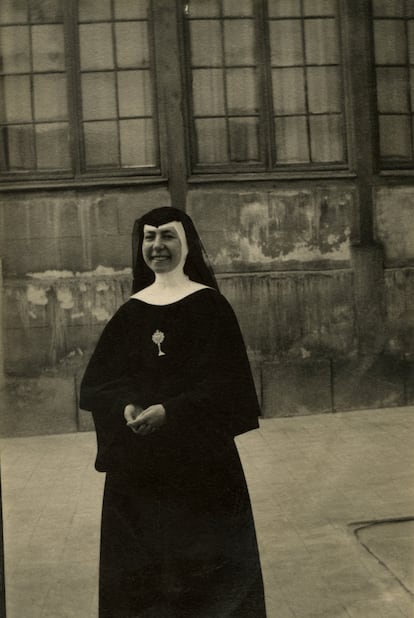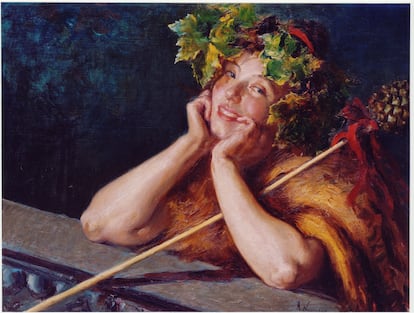When the Prado Museum was able to reopen its doors in November 2020 after the closure forced by the coronavirus, it offered a historic exhibition. Under the title of Guests. Fragments on women, ideology and plastic arts in Spain (1833-1931) 130 works could be seen, many of which had never been exhibited or had been seen very little. There were many surprises then, although perhaps the biggest and most talked about was woman’s nude, a painting with which Aurelia Navarro (Pulianas, Granada, 1882 – Córdoba, 1968) competed in 1908 at the National Exhibition of Fine Arts and won the third medal. He was 26 years old and had an immense desire to take on the world. He entered the competition on two more occasions and won new medals again. It is believed that he painted almost a hundred paintings. Almost always young women and girls. His loose brushwork and technical mastery sparked the interest of his colleagues and professors. But at the age of 38 she slammed the door on her conventional and supposedly comfortable Granada world and entered the convent of the Adoratrices of Granada. Renamed Sister Aurelia María de la Resurrección, she died in the convent of Córdoba at the age of 85.
The reasons why Aurelia Navarro made the decision to change brushes for habits point to the marginalization and contempt that women artists suffered then in a world in which only men ruled. Aurelia Navarro was not an ordinary artist nor was her decision the most pleasant. As evidence of the interest that his work and person have aroused, until the Prado exhibition his career did not exceed three lines in the Espasa encyclopedia.
Several publications have been published based on the exhibition, including two complete monographs. The first is titled Profile of an artist against the current (Presses of the University of Zaragoza, 2021), a research by Magdalena Illán Martín, professor of Art at the University of Seville. The second study is Aurelia Navarro, an undiscovered painter from Granada (Granada Artistic Association, 2022), signed by María Dolores Santos, doctor in Art History from the University of Granada. The third book has just arrived in bookstores, and is in the form of a fictionalized biography: Paint nudes, end up a nun (Figurehead, 2024). Its author, Nerea Aznar (Granada, 49 years old), has resorted to “believable fiction,” in the writer’s words, to reconstruct the artist’s life in her hometown and answer the many questions raised.
While research enriches knowledge about Aurelia Navarro, her work has entered the Prado Museum with all honors. Thanks to a family donation (Pablo Navarro Holgado), the permanent collection displays an artist (1906), a possible self-portrait of the painter with a brush in her hand. In the opinion of Carlos G. Navarro, commissioner of Guests and head of Conservation of 19th Century Paintings and Drawings at the museum, is a work of immense quality: “This is one of those images of his starring women that transcend the strictly feminine universe. Your artistic field is very important and I am very happy that Guests has made it possible for someone like her to go from anonymity to occupy an important place in research centers and museums. It is very good that his work is made known.”
‘Ecstasy’, his last painting
In Granada, the Museo Casa de los Tiros (city museum and archive) has already dedicated its own room to her, bringing together the five works by Aurelia Navarro that are publicly owned or in storage. It is an expandable background in which the star will be the famous woman nude as soon as I return from the exhibition on the history of the nude that can be seen at the Carmen Thyssen Museum in Malaga until March 9. In the Casa de los Tiros you can already see another of the most notable and special paintings by Aurelia Navarro, Ecstasy (1916), donated to the museum by Julia Marchena Navarro, great-niece of the artist, in 2022. As far as is known, it is the last one she painted outside the convent. In the painting you can only see the face of a beautiful young woman in full sexual ecstasy. He holds his head with one arm and the shoulder is barely visible with the other. It is not known what the original dimensions were. It is cut on one side and on the bottom. Everything indicates that it was her father, José Navarro, a very well-placed and deeply conservative doctor, who forced her to eliminate parts of the fabric. It may be that José Navarro and his wife, Resurrección Moreno, found it indigestible to continue being the talk of the most stale and blessed Granada because of their daughter. Aurelia had a brother, José, also a doctor, with whom she always enjoyed an extraordinary relationship. José, his five children and then his grandchildren have been the guardians of a legacy that remains practically complete in their hands.

In her Madrid home, Julia Marchena Navarro shows walls full of paintings by her great-aunt. Girls and young women were portrayed absorbed in their chores or daydreams. Some are girls from Albaicín, others belong to their family and social environment. She took self-portraits very frequently, something very common for artists who are starting out and don’t have money to pay for models. In one of these self-portraits that adorn her niece Julia’s house, she is 22 years old, with a firm look and a long, slender neck semi-covered with lace. Nearby is another self-portrait in which his expression has lost strength and security. Both the great-niece and the researchers believe that the famous and award-winning nude is also a self-portrait. Conceived as a Venus in the mirror of her admired Velázquez, it is the artist’s distorted face that is reflected in the mirror. Julia Marchena says that the prize achieved for that painting consisted of a diploma and the purchase of the painting by Fine Arts. They failed to comply.

The Provincial Council of Granada responded and kept it for 2,000 pesetas, which they did not allow her to manage due to the legal paternalism of the time. One of the conditions of the purchase was that the painting be exhibited to the public, but for decades it remained “adorning” an office of the Provincial Council until the Prado requested it for its exhibition. Guests. Julia Marchena does not have an opinion about her aunt’s abandonment of painting, although she is convinced that her grandparents’ society must have been suffocating for a young artist.
Travel prohibited
Until her entry into the Adorers, Aurelia always lived in the family home. He did not travel to Madrid to present his works in the competitions. His teachers, José Larrocha and Tomás Muñoz Lucena, took his place. The latter tried to convince her father to have Aurelia study in Rome. Given the negative response, Muñoz Lucena asked to marry Aurelia. Another strong refusal was found because the parents feared that pairing with the widowed professor and father of three children would be a way for her to give free rein to her authentic tastes and feelings.
The fictionalized biography of Nerea Aznar attempts to provide answers to the many questions surrounding the life of an artist who sometimes recalls the protagonists of Pérez Galdós and Federico García Lorca. Aznar, a writer and professor from Granada, has dedicated almost two years to researching and matching data in the archives and among the family. There are many things in the novel that are unprovable, since when Aurelia decides to leave society, her family makes all the letters, notes and photographs that she kept disappear.

Based on these investigations, in her book, Nerea Aznar alternates the voice of the artist with that of an anti-heroine. The work tells of the family’s origins in the town of Pulianas, their life in Plaza Nueva, their few relationships with friends or their love of walking through the Alhambra forest or sitting with their easel in the patios of the Nasrid palaces. Relive some of the most terrible events and events that he experienced: the earthquake of 1884, the rise of the sugar factories, the creation of the Artistic, Literary and Scientific Center, the construction of the Gran Vía or the Cante Jondo Competition of 1922 and He relates her to male artists with whom she surely never spoke: Falla, Rodríguez-Acosta, López Mezquita, Madrazo or Federico García Lorca.
Homosexuality
Nerea Aznar elaborates on one of the possible causes of her isolation and dissatisfaction: her homosexuality. In the novel, his relationship with Alicia Morandi, daughter of an infantry captain of Italian origin, living in Spain, who had been assigned to Granada, is told. They give free rein to their love until the environmental pressure feeds an atrocious fear in Alicia, and the relationship ends with the departure of the Italians. From this fiction (plausible, according to the author and part of the family), Aurelia is left alone. She has no orders, no love, no illusion and decides to enter the convent of the Adorers in 1923, becoming Sister Aurelia María de la Resurrección. Until then she had painted almost a hundred paintings. In the convent, dedicated to teaching and prayer, she made some religious tablets and a portrait of Mother Micaela, founder of the Adorers, in 1934. She died in Córdoba in 1968, at the age of 85.

